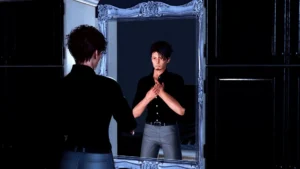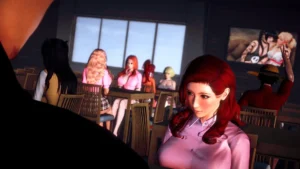
Desire of Fate
Play Desire of Fate
Desire of Fate review
A Deep Dive into the Narrative Mechanics and Player Experience
In the evolving landscape of interactive storytelling, Desire of Fate emerges as a title blending choice-driven narratives with emotional depth. This immersive experience challenges players through morally complex decisions that shape relationships and outcomes. Unlike traditional visual novels, the game employs a dynamic alignment system where character motivations evolve based on player interactions, creating unique pathways through its rich fantasy world.
Narrative Architecture & Character Dynamics
Narrative Architecture & Character Dynamics
Ever played a game where your choices actually matter? 🎮💥 If you’re fed up with stories that railroad you into a single ending, Desire of Fate is here to flip the script. This fantasy visual novel doesn’t just pretend to care about your decisions—it builds entire worlds around them. Let’s crack open its branching paths, dissect the character relationship system, and see how every dialogue option can send ripples through the story. Buckle up—this is narrative design with teeth.
Branching Storyline Design Philosophy
Picture this: You’re sneaking through a moonlit castle, and you stumble on a wounded guard. Do you heal him, slit his throat, or leave him to fate? In Desire of Fate, there’s no “right” answer—just narrative choice consequences that reshape kingdoms. 🏰⚔️ The game’s three-act structure isn’t just a framework; it’s a living ecosystem. Act 1 plants seeds (meet the rebellious mage, learn about the crumbling empire), Act 2 lets those choices bloom (allies betray you, lovers lie), and Act 3? Let’s just say someone’s getting stabbed in the back… maybe by you.
The secret sauce? A karma-based alignment system that tracks your moral compass. But forget “good vs. evil”—here, it’s about intent. Save a village to gain political power? That’s “Pragmatic.” Save it because you’re a softie? “Noble.” Ignore it to chase your crush? “Renegade.” Lead writer Elena Voss jokes, “We wanted every choice to feel like dropping a pebble in a pond. Sometimes you get a ripple. Sometimes you get a tsunami.” 🌊
And oh, the fantasy visual novel mechanics! Dialogue isn’t just text—it’s a weapon. Pick a flirtatious line, and the brooding knight might later sabotage your rivals. Mock a deity, and temples lock their doors. Even silence has weight. One beta tester reportedly spent 20 minutes agonizing over whether to pet a stray cat (it’s a shapeshifting spy, by the way). 🐈⬛🔍
| Alignment Path | Core Values | Story Impact |
|---|---|---|
| Noble | Honor, Sacrifice, Loyalty | Unlock peaceful resolutions; allies trust you implicitly |
| Pragmatic | Strategy, Ambition, Adaptability | Gain political leverage; factions court your favor |
| Renegade | Freedom, Chaos, Self-Interest | Access black markets; NPCs fear or admire your ruthlessness |
💡 Pro Tip: “Save often, but don’t reload after ‘bad’ choices. Desire of Fate thrives on chaos. Let the story get messy!” — Lead Designer Marcus Li
Relationship Systems and Emotional Payoffs
Let’s talk about the elf prince who hates your guts. 🧝♂️💔 In most games, you’d spam gifts until he simpers. Here? His disdain sticks. The character relationship system isn’t a popularity contest—it’s a web of memories. Forget a character’s birthday? They’ll bring it up three chapters later. Defend them in a duel? They might take an arrow for you… or resent you for making them owe a debt.
Romance isn’t just about steamy scenes (though, hey, those exist 🌹). It’s about vulnerability. One arc forces you to choose between exposing your magical corruption to your partner or lying—a decision that splits the storyline into “redemption” or “downfall” arcs. Voice actor Clara Nguyen admits, “I cried recording the breakup scene. It’s raw, like watching a relationship implode in real time.”
And the emotional engagement strategies? Brutal. The game uses:
– Dynamic music: Themes shift based on who’s nearby (your lover’s melody becomes discordant if they’re hiding secrets).
– Environmental cues: A dying campfire mirrors a fading friendship.
– Silent choices: Sometimes, walking away speaks louder than dialogue.
Thematic Depth in Fantasy Worldbuilding
Desire of Fate’s world isn’t just dragons and castles—it’s a mirror. 🪞✨ The crumbling empire reflects real-world issues like class strife and climate decay (yes, melting ice caps are a plot point). But it’s subtle. You’ll find hints in graffiti (“The Crown feasts while we starve”), overhear tavern rumors about rebel factions, or stumble on a beggar who’s actually a disgraced general.
Environmental storytelling is king. A library’s burnt section? That’s censored history. A statue missing its head? The locals revolted. Art director Sofia Ramirez grins, “We hid lore in everything. Even the ale labels have political slogans.” 🍻🗡️
And the protagonist-antagonist dynamic? No mustache-twirling villains here. The main foe, Lady Veyra, has motives you’ll almost sympathize with. Betray her, and she’ll hiss, “You’d have done the same in my place.” Chilling… because she’s right.
So, why does Desire of Fate claw into your psyche? Because it treats branching paths not as gimmicks, but as conversations. Every choice whispers, “This is who you are.” Every relationship forces you to ask, “What am I willing to lose?” And the fantasy visual novel mechanics? They’re not just buttons—they’re brushstrokes in a masterpiece you paint with your conscience. Ready to play god? 🔥📖
Desire of Fate redefines interactive storytelling through its sophisticated narrative systems and emotional character arcs. By prioritizing player agency and meaningful consequences, it sets a new standard for mature-themed visual novels. Experience the evolving relationships and world-shaping decisions yourself through the game’s free demo edition.



























